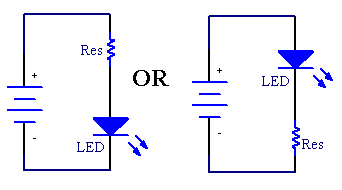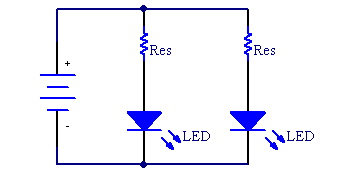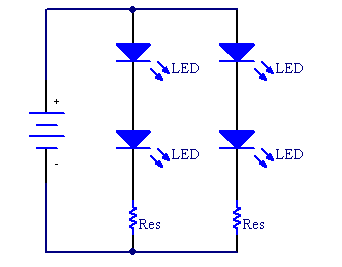LED
(Difference between revisions)
Deanodriver (Talk | contribs) |
m |
||
| Line 1: | Line 1: | ||
| + | Back to [[Modding %26 Electronics]] | ||
| + | |||
A light-emitting diode (LED) is a specialised type of semiconductor PN-juntion diode that emits incoherent narrow-spectrum light when electrically biased in the forward direction. | A light-emitting diode (LED) is a specialised type of semiconductor PN-juntion diode that emits incoherent narrow-spectrum light when electrically biased in the forward direction. | ||
Latest revision as of 17:06, 1 March 2010
Back to Modding & Electronics
A light-emitting diode (LED) is a specialised type of semiconductor PN-juntion diode that emits incoherent narrow-spectrum light when electrically biased in the forward direction.
Charge-carriers - electrons and electron holes - flow into the PN-junction from electrodes with different voltages. When an electron meets a hole, it falls into a lower energy level, and releases energy in the form of a photon as it does so.
The wavelength of the light emitted, and therefore its color, depends on the band gap energy of the materials forming the p-n junction. In silicon or germanium diodes, the electrons and holes recombine by a non-radiative transition which produces no optical emission, because these are indirect bandgap semiconductors. The materials used for LEDs are direct bandgap semiconductors with energies corresponding to near-infrared, visible or near-ultraviolet light wavelengths.
Free standing LEDs are usually constantly illuminated when a current passes through them, but flashing LEDs are also available. Flashing LEDs resemble standard LEDs but they contain a small chip inside which causes the LED to flash with a typical period of one second. This type of LED comes in all colours, though is most commonly available as red, yellow, or green. Most flashing LEDs emit light of a single wavelength, but multicoloured flashing LEDs are available too, consisting of several different LEDs, made from different semiconductor materials, combined into a single physical package along with a controlling IC. Because of the integrated electronics, these LED's can often be powered from a DC power supply at a suitable voltage, say 5V, without the normal electrical considerations which must be applied to the use of LEDs in circuits.
Conventional LEDs are made from a variety of inorganic semiconductor materials, producing the following colors:
* Aluminum Gallium Arsenide (AlGaAs) - red and infrared * Aluminum Gallium Phosphide (AlGaP) - green * Aluminum Gallium Indium Phosphide (AlGaInP) - high-brightness orange-red, orange, yellow, and green * Gallium Arsenide phosphide (GaAsP) - red, orange-red, orange, and yellow * Gallium Phosphide (GaP) - red, yellow and green * Gallium Nitride (GaN) - green, pure green (or emerald green), and blue * Indium Gallium Nitride (InGaN) - near ultraviolet, bluish-green and blue * Silicon Carbide (SiC) as substrate - blue * Silicon (Si) as substrate - blue (under development) * Sapphire (Al2O3) as substrate - blue * Zinc Selenide (ZnSe) - blue * Diamond (C) - ultraviolet * Aluminum Nitride (AlN), Aluminum Gallium Nitride (AlGaN) - near to far ultraviolet
This chart shows the wide range of LED wavelengths on the market today, along with the corresponding semiconductor chemistry and typical forward voltage drop of the device. Because the forward voltage drop is closely related to the characteristics of the particular semiconducor material in question, it is possible to estimate the forward voltage drop for a LED of a given colour, if specific data is not available. This is useful for practical application of LEDs where specific data may not be available for the devices.
Contents |
[edit] Practical application of LEDs
Like any conductive material, as the current through a LEDs semiconductor die is increased, heat dissipation will increase the temperature of the material. However, unlike metals, semiconductors have a positive coefficent between electrical conductivity and temperature, meaning that if the current through a fully forward-biased LED is not controlled by some external factor in the circuit, thermal runaway will destroy the LED.
If we have one or more LEDs in a series circuit with some voltage supply, Ohms Law allows suitable characteristics of the circuit to be calculated such that the LEDs are operated correctly, as follows:
- <math>V = I \cdot R</math>
Thus, in a simple series circuit consisting of several LEDs in series with a voltage source and some resistance R,
<math>V_resistor = IR</math>
Note that <math>V_resistor</math> is the voltage across the resistor only. Because the voltage drop across the LEDs is going to be essentially constant, it follows that
<math>V_resistor = V_{s} - nV_{f}</math>
Where <math>V_{s}</math> is the supply voltage of the circuit, say 12V DC, <math>V_{f}</math> is the forward voltage of the LED, for example ~3.5V for a typical blue LED, and n is the number of LED's in series, say three, - this assumes that all the LEDs are identical, if not, it's still the sum the forward voltage of each device.
<math>I_{f}</math> is the rated forward current of the LED(s), say for example 20mA. Exceeding this figure too much will destroy the LED. In this series circuit, <math>I = I_{f}</math>.
From the above, it follows that <math>R = \frac{V_{s} - \SigmaV_{f}}{I_{f}}</math>.
Using my example data, this is <math>R = \frac{12 - (3 * 3.5)V}{20 mA}</math>, or <math> \frac{1.5}{20 * 0.001} = 75 Ohms. In most cases the nearest E12 standard value is desired, in our case R = 69 Ohms would run the LEDs at an acceptable current.
<more to come later>
<work below is in progress>
[edit] LED Circuit Diagrams
[edit] Single LED Circuit
<>
<>
<>
<>
<>
<>
<>
<>
<>
<>
[edit] Parallel LED Circuit
<>
<>
<>
<>
<>
<>
<>
<>
<>
<>
[edit] Series LED Circuit
<>
<>
<>
<>
<>
<>
<>
<>
<>
<>
<>
<>
<>
<>
[edit] Combination Parallel/Series LED Circuit
<>
<>
<>
<>
<>
<>
<>
<>
<>
<>
<>
<>
<>
<>
| Color | Semiconductor materials |
|---|---|
| Red and infrared | Aluminum Gallium Arsenide (AlGaAs) |
| Green | Aluminum Gallium Phosphide (AlGaP) |
| High-brightness orange-red, orange, yellow, and green | Aluminum Gallium Indium Phosphide (AlGaInP) |
| Red, orange-red, orange, and yellow | Gallium Arsenide phosphide (GaAsP) |
| Red, yellow and green | Gallium Phosphide (GaP) |
| Green, pure green (or emerald green), and blue | Gallium Nitride (GaN) |
| Near ultraviolet, bluish-green and blue | Indium Gallium Nitride (InGaN) |
| Blue | Silicon Carbide (SiC) as substrate |
| Blue (under development) | Silicon (Si) as substrate |
| Blue | Sapphire (Al2O3) as substrate |
| Blue | Zinc Selenide (ZnSe) |
| Ultraviolet | Diamond (C) |
| Near to far ultraviolet | Aluminum Nitride (AlN) / Aluminum Gallium Nitride (AlGaN) |
![[Main Page]](http://www.overclockers.com.au/wiki/skins/common/images/wiki.png)



